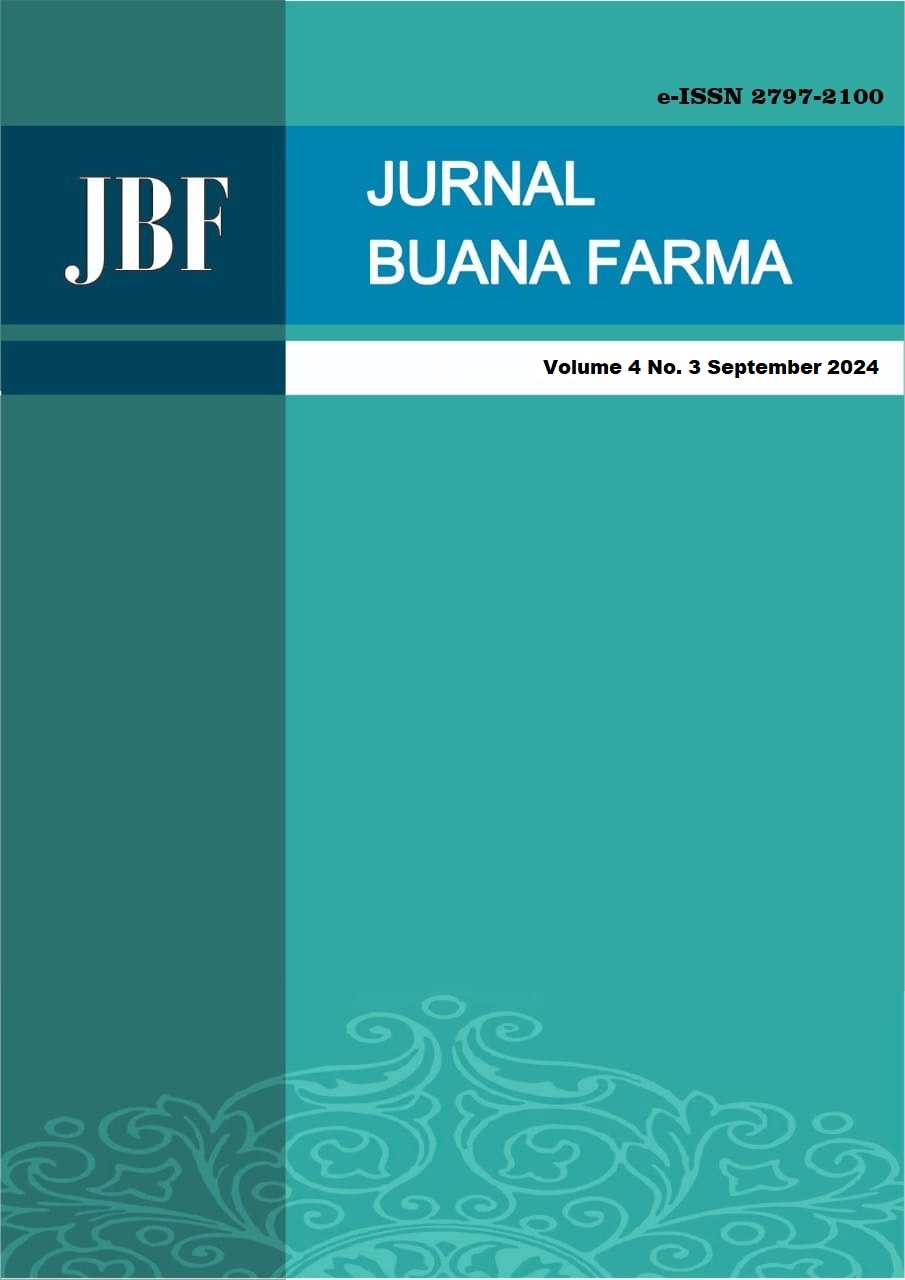KAJIAN RASIONALITAS PENGGUNAAN ANTIBIOTIK PADA ANAK DENGAN INFEKSI SALURAN KEMIH DI RSUD Dr. MOEWARDI SURAKARTA
Abstract
Urinary tract infection (UTI) is the second highest infectious disease among children in Indonesia. Management of UTI requires antibiotic therapy, but the irrational use of antibiotics makes this disease one of the contributors to the high rate of antibiotic resistance. Therefore, there is a need for a study to measure the rationality of antibiotic use in children with UTI. This study is a descriptive observational study with a cross sectional design. Data were collected retrospectively using a purposive sampling technique based on medical record data of pediatric patients at Dr. Moewardi Surakarta Hospital in 2021-2023. The results showed that out of 100 medical records of pediatric patients with UTI, 68.00% were women and 32.00% were men. Based on age, the highest incidence of UTI occurred in the age range of 10-18 years as much as 52.00%. The most common antibiotic use was ampicillin 68.00%. The results of the rationality study showed 69.00% in category 0 (rational use of antibiotics). Irrationality occurred in category IIA (antibiotic use is not the right dose) 17.00%, IIIA (antibiotic use with too long duration) 1.00%, IIIB (antibiotic use with too short duration) 4.00%, IIA & IIIB (antibiotic use is not the right dose & duration is too short) 2.00%, IVA (there are other more effective antibiotic options) 4.00%, IIIB & IVA (antibiotic use is too short duration & there are other more effective antibiotic options) 3.00%. It can be concluded that the rational use of antibiotics needs to be improved.
References
Adhitama, W., Puspitasari, I., & Laksanawati, I. S. (2021). Evaluasi Luaran Klinis Terapi Antibiotika Pada Pasien Anak Rawat Inap Dengan Infeksi Saluran Kemih di RSUP Dr. Sardjito Yogyakarta. Majalah Farmaseutik, 17(2), 166. https://doi.org/10.22146/farmaseutik.v17i2.48803
Alansyah, S. (2018). Analisis Penggunaan Antibiotik Pada Pasien Anak Dengan Infeksi Saluran Kemih Di Instalasi Rawat Inap RSUD dr. Soediran Mangun Sumarso Wonogiri Tahun 2017 Periode Januari-Juli. Program Studi Farmasi, Universitas Setia Budi, Surakarta.
Amrullah, A. W., Purwaningsih, A. E. D. A., Rahardjoputro, R., & Murharyati, A. (2022). Evaluasi Rasionalitas Penggunaan Antibiotik Pada Pasien Dengan Infeksi Saluran Kemih di Rumah Sakit X di Surakarta. 73613 | Jmpf, 12(2), 116–124.
Anggita, D., Nurisyah, S., & Wiriansya, E. P. (2022). Mekanisme Kerja Antibiotik: Review Article. UMI Medical Journal, 7(1), 46–58. https://doi.org/10.33096/umj.v7i1.149
Anggraini, W., Candra, T. M., Maimunah, S., & Sugihantoro, H. (2020). Evaluasi Kualitatif Penggunaan Antibiotik pada Pasien Infeksi Saluran Kemih dengan Metode Gyssens. KELUWIH: Jurnal Kesehatan dan Kedokteran, 2(1), 1–8. https://doi.org/10.24123/kesdok.v2i1.2876
Dipiro, J., Yee, G., Haines, M., Nolin, T., & Elingrod, V. (2020). Pharmacotheraphy: A Phatophysiologic Approach Eleventh Edition. In American Journal of Health-System Pharmacy (11 ed.). https://doi.org/10.1093/ajhp/54.14.1668
Erna Irawan, H. M. (2018). Faktor-Faktor Penyebab Infeksi Saluran Kemih (ISK) (Literature Review). Prosiding Seminar Nasional dan Penelitian Kesehatan 2018, 1(1), 2013–2016. https://doi.org/10.31227/osf.io/yt8nz
Hapipah, I., Henny, K., Rina, K., Simon, M., Making, M., Banase, E., Aini, L., Aty, Y., Jaata, C., Sari, Y., Rohmawati, D., & Susanti, E. (2020). Asuhan Keperawatan Pasien Dengan Gangguan Sistem Perkemihan Berbasis SDKI, SLKI dan SIKI (1 ed.).
Hashary, A. R., Manggau, M. A., & Kasim, H. (2018). Analisis Efektivitas Dan Efek Samping Penggunaan Antibiotik Pada Pasien Infeksi Saluran Kemih Di Instalasi Rawat Inap RSUP Dr. Wahidin Sudirohusodo Makassar. Majalah Farmasi dan Farmakologi, 22(2), 52–55. https://doi.org/10.20956/mff.v22i2.5701
Herlina, D., Hasina, R., & Dewi, N. M. A. R. (2021). Pola Peresepan Antibiotik Pada Pasien Infeksi Saluran Kemih Di Instalasi Rawat Jalan RSUD Provinsi NTB Tahun 2017. Sasambo Journal of Pharmacy, 2(1), 11–15. https://doi.org/10.29303/sjp.v2i1.26
Inez, A., Nurmainah, & Susanti, R. (2019). Evaluasi Rasionalitas Penggunaan Antibiotik pada Pasien Anak Rawat Inap di Rumah Sakit Universitas Tanjungpura Periode Januari-Juni 2018. Journal of Chemical Information and Modeling, June, 1–15. https://jurnal.untan.ac.id/index.php/jmfarmasi/article/viewFile/37615/75676584033
Jatnika, A. (2018). Analisis Efektivitas Biaya Penggunaan Antibiotik Pada Pasien Infeksi Saluran Kemih Di rawat Inap Rumah Sakit Al Islam Bandung. In Skripsi. Program Studi Farmasi, Universitas Al-Ghifari, Bandung.
Kemenkes RI. (2015). Peraturan Menteri Kesehatan Republik Indonesia Nomor 8 Tahun 2015 Tentang Program Pengendalian Resistensi Antimikroba Di Rumah Sakit. 1–32.
Kemenkes RI. (2021). Peraturan Menteri Kesehatan Republik Indonesia Nomor 28 Tahun 2021 Tentang Pedoman Penggunaan Antibiotik. 1–97.
Lavan, A. H., Gallagher, P. F., & O’Mahony, D. (2016). Methods to reduce prescribing errors in elderly patients with multimorbidity. Clinical Interventions in Aging, 11, 857–866. https://doi.org/10.2147/CIA.S80280
Musdalipah, M. (2018). Identifikasi Drug Related Problem (Drp) Pada Pasien Infeksi Saluran Kemih Di Rumah Sakit Bhayangkara Kendari. Jurnal Kesehatan, 11(1), 39–50. https://doi.org/10.24252/kesehatan.v11i1.4908
Nurhalimah, Nurmainah, & Robiyanto. (2015). Efektivitas Penggunaan Seftriakson Dan Sefotaksim Pada Pediatri Penderita Infeksi Saluran Kemih Di RSUD Sultan Syarif Mohamad Alkadrie Pontianak. Jurnal Farmasi UNTAN, 3(1).
Paluseri, A., Fitri Bagian Farmakologi, A., Tinggi Ilmu Farmasi Makassar, S., & Perintis Kemerdekaan, J. K. (2020). Cost Effectiveness of Ciprofloxacin versus Cotrimoxazole in the Treatment of Urinary Tract Infection at Hasanuddin University Hospital, Makassar. Journal of Pharmaceutical and Medicinal Sciences, 5(1), 7–14.
Rahayuningrum, D. C., Patricia, H., Apriyeni, E., Yulandari, P., Studi, P., Keperawatan, S., Syedza, S., & Padang, S. (2023). Faktor-Faktor Yang Mempengaruhi Kemandirian Toilet Training Pada Anak Usia Pra Sekolah (3-5 Tahun). Jurnal Kesehatan Medika Saintika, 14(1), 243–253.
Ritonga, I. (2024). Gambaran Penggunaan Antibiotik pada Pasien Infeksi Saluran Kemih Di RSUD Cut Meutia. In Skripsi. Program Studi Kedokteran Universitas Malikussaleh, Lhoksumawe.
Septiana Kurniasari, Fauzan Humaidi, & Ida Sofiyati. (2020). Penggunaan Antibiotik Oleh Penderita Infeksi Saluran Kemih Di Instalasi Rawat Inap (IRNA) 2 RSUD Dr. H. Slamet Martodirdjo Pamekasan Tahun 2019. Jurnal Ilmiah Farmasi Attamru, 01(01), 19–20.
Soraya. (2017). Gambaran Rasionalitas Penggunaan Antibiotik Pasien Penyakit Infeksi Saluran Kemih Pada Anak. In Skripsi. Program Studi Farmasi, Universitas Muhammadiyah Banjarmasin.
Susanti, D., & Lutfiyati, A. (2020). Hubungan Pengetahuan Remaja Putri Dengan Perilaku Personal Hygiene Saat Menstruasi. Jurnal Kesehatan Samodra Ilmu, 11(2), 166–172. https://doi.org/10.55426/jksi.v11i2.119
Tusino, A., & Widyaningsih, N. (2018). Karakteristik Infeksi Saluran Kemih Pada Anak Usia 0- 12 Tahun Di RS X Kebumen Jawa Tengah. Biomedika, 9(2), 39–46. https://doi.org/10.23917/biomedika.v9i2.5842
Useng, A. (2014). Analisis Penggunaan Antibiotik Pada Penyakit Infeksi Saluran Kemih Berdasarkan Evidence Based Medicine (EBM) Di Rumah Sakit “X” Periode januari-Juni 2013. In Skipsi. Program Studi Farmasi, Universitas Muhammadiyah Surakarta.
Widi, A. (2022). Antibiotik Dan Resistensi Antibiotik (Risnawati (ed.); 1 ed.). Rizmedia Pustaka Indonesia.
Yuliana, A. (2015). Uji Sensitivitas Antibiotik Levofloxacin Yang Ada Di Pasaran Terhadap Bakteri Salmonella thyphosa ATCC 2401. Jurnal Kesehatan Bakti Tunas Husada: Jurnal Ilmu-ilmu Keperawatan, Analis Kesehatan dan Farmasi, 14(1), 12. https://doi.org/10.36465/jkbth.v14i1.105
Yunita, T. (2016). Evaluasi Rasionalitas Penggunaan Antibiotika pasien Infeksi Saluran Kemih Di Instalasi Rawat Inap RS Bethesda Yogyakarta Tahun 2015. In Skripsi. Program Studi Farmasi, Universitas Sanata Dharma, Yigyakarta.













